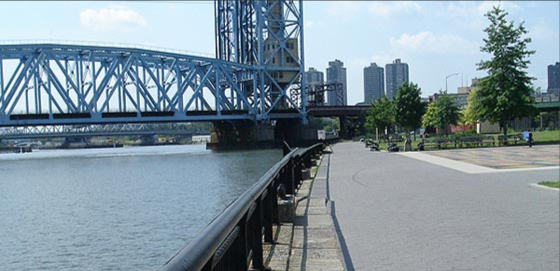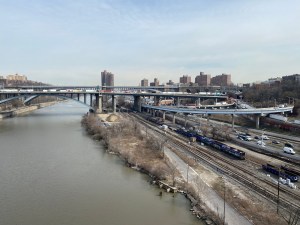DOT Proposes Safety Fixes to Help People Reach Harlem River Park
 Bridge traffic and very wide streets make the intersection of 135th and Madison difficult for pedestrians to cross, impeding access to the Harlem River Park. Image: Google Street View
Bridge traffic and very wide streets make the intersection of 135th and Madison difficult for pedestrians to cross, impeding access to the Harlem River Park. Image: Google Street ViewOne of the biggest planning stories of the last decade is undoubtedly the opening of the New York City waterfront to the public. Across much of the city, however, the automobile still occupies the prime waterfront spaces.
The fate of Harlem River Park exemplifies the challenges of bringing recreation to a riverside dominated by the Harlem River Drive. The park is new and beautiful, but underused. It’s no surprise. To get into the park, pedestrians and cyclists have to walk by a series of ramps and access roads funneling huge volumes of traffic between the highway and the many nearby bridges, most of which are free. Local residents and the Harlem Community Development Corporation have been raising the issue for years and since 2007, Transportation Alternatives has worked with them to develop a set of recommendations for improvements [PDF].
To try and knit the community together with its park, DOT is developing a set of safety improvements for the intersections near park entrances, particularly 135th and Madison, 139th and Fifth, and 142nd and Fifth. Interestingly, Transportation Alternatives’ CrashStat map shows that these intersections aren’t the locations in the neighborhood with the most crashes, by a long-shot. It seems that pedestrians and cyclists are so deterred by the unsafe conditions there that many don’t even venture over.
 This beautiful park can’t serve the community if it’s not safe to walk there. Photo: Harlem River Park.
This beautiful park can’t serve the community if it’s not safe to walk there. Photo: Harlem River Park.Early stages of the plan were unveiled at a presentation at Harlem Hospital last Wednesday (a more final proposal will be submitted to Community Board 11 in September). According to Streetsblog reader BicyclesOnly, who attended the meeting, possible safety improvements included narrowing roads, adding pedestrian refuge islands and Greenstreets plantings, and changing traffic patterns in the area. At 135th and Madison, for example, DOT proposed narrowing and reversing the direction of the northern service road to the Madison Avenue Bridge offramp, in addition to installing refuge islands to shorten the distance across the roadway.
Community members who attended the meeting weren’t sold on all of DOT’s suggestions, according to BicyclesOnly. Many would have preferred to add or extend leading pedestrian intervals to the crossings, giving pedestrians more of a head start into the intersection. DOT told the crowd that wasn’t an option due to the volume of traffic in the area. Regardless, everyone in the audience desperately understood the need for safety improvements.
In fact, in some ways the audience was urging DOT to go further than it could. Many residents complained that the pedestrian bridges that take you over the highway and into the park were too steep for seniors to use, limiting access to the park. They wanted the Harlem River Drive to be turned into a boulevard, like West Street, so that you could cross to the park at-grade, with traffic signals. DOT representatives replied that such a change falls under the jurisdiction of the state DOT.

